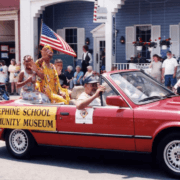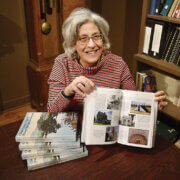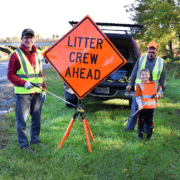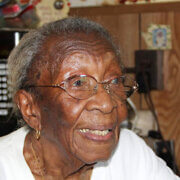Seeds On The Wind
By Doug Pifer
Looking out the kitchen window one morning last week, I thought it had started to snow. When I went out later, I saw that my “snowflakes” were really the fluffy seeds of sycamore trees. After hanging all winter packed tightly into “buttonwood balls,” they had broken free. Each individual nutlet had a bright buffy parachute that carried it away on the wind. Fluffy sycamore snowflakes drifted in windrows along the road, sticking to the muddy ground and piling up next to the fence.
Dispersal of seeds by wind, called anemochory, is a reproductive strategy of many trees, shrubs, and wildflowers. Wind dispersal gives seeds a much better chance to germinate than if they just fell to the ground under the plant. Tree anemochores include maples, tulip trees, and ashes, as well as cone bearing pines and spruces. All these produce winged seeds that twirl like helicopters. Sycamore and cottonwood trees, and wildflowers such as dandelion and milkweed, practice anemochory by releasing their seeds into the wind on silky parachutes.
Early spring winds also disperse pollen, sometimes in dramatic ways. One day I looked out the window and thought I saw smoke coming from the grove of red cedar trees in our middle pasture. My panic left me when I realized it was just the wind blowing clouds of cedar pollen. Red cedars are either male or female. Female red cedars are easily recognized in late summer when hundreds of small, waxy cones turning from green to powder-blue fill their branches. Male cedars are less striking until late winter, when thousands of tiny reddish-brown cones at the ends of their branches open and release pollen. These cones often grow so densely they turn the tree from dull green to brick-red. On dry, warm days as early as mid-February, the fragrance of cedar fills the air. The slightest breeze, or even a bird alighting on the branches, releases a cloud of pollen. A stiff wind blowing through a grove of male cedar trees on a warm, dry winter day can look like smoke from a grass fire.
Wind pollinated flowers of red, silver and sugar maple trees burst forth in late winter and early spring. The flowers are so small they often go unnoticed. Yet, from a distance every maple tree in the woods wears a red, orange or pink halo, bright tints of spring against the wintry gray of surrounding trees.
As folks who tap maple trees know, when maple trees bloom in late winter, maple tree sap turns as bitter as the March wind, marking the end of the sugar-making season. But to the squirrels, maple flowers are a feast, coming just as the first of their babies are born. Last week I saw a gray squirrel swinging in the wind, hanging onto an outer branch of a silver maple while nibbling the flowering buds. It reminded me that, despite the cold, spring is on its way.
Looking out the kitchen window one morning last week, I thought it had started to snow. When I went out later, I saw that my “snowflakes” were really the fluffy seeds of sycamore trees. After hanging all winter packed tightly into “buttonwood balls,” they had broken free. Each individual nutlet had a bright buffy parachute that carried it away on the wind. Fluffy sycamore snowflakes drifted in windrows along the road, sticking to the muddy ground and piling up next to the fence.
Dispersal of seeds by wind, called anemochory, is a reproductive strategy of many trees, shrubs, and wildflowers. Wind dispersal gives seeds a much better chance to germinate than if they just fell to the ground under the plant. Tree anemochores include maples, tulip trees, and ashes, as well as cone bearing pines and spruces. All these produce winged seeds that twirl like helicopters. Sycamore and cottonwood trees, and wildflowers such as dandelion and milkweed, practice anemochory by releasing their seeds into the wind on silky parachutes.
Early spring winds also disperse pollen, sometimes in dramatic ways. One day I looked out the window and thought I saw smoke coming from the grove of red cedar trees in our middle pasture. My panic left me when I realized it was just the wind blowing clouds of cedar pollen. Red cedars are either male or female. Female red cedars are easily recognized in late summer when hundreds of small, waxy cones turning from green to powder-blue fill their branches. Male cedars are less striking until late winter, when thousands of tiny reddish-brown cones at the ends of their branches open and release pollen. These cones often grow so densely they turn the tree from dull green to brick-red. On dry, warm days as early as mid-February, the fragrance of cedar fills the air. The slightest breeze, or even a bird alighting on the branches, releases a cloud of pollen. A stiff wind blowing through a grove of male cedar trees on a warm, dry winter day can look like smoke from a grass fire.
Wind pollinated flowers of red, silver and sugar maple trees burst forth in late winter and early spring. The flowers are so small they often go unnoticed. Yet, from a distance every maple tree in the woods wears a red, orange or pink halo, bright tints of spring against the wintry gray of surrounding trees.
As folks who tap maple trees know, when maple trees bloom in late winter, maple tree sap turns as bitter as the March wind, marking the end of the sugar-making season. But to the squirrels, maple flowers are a feast, coming just as the first of their babies are born. Last week I saw a gray squirrel swinging in the wind, hanging onto an outer branch of a silver maple while nibbling the flowering buds. It reminded me that, despite the cold, spring is on its way.










